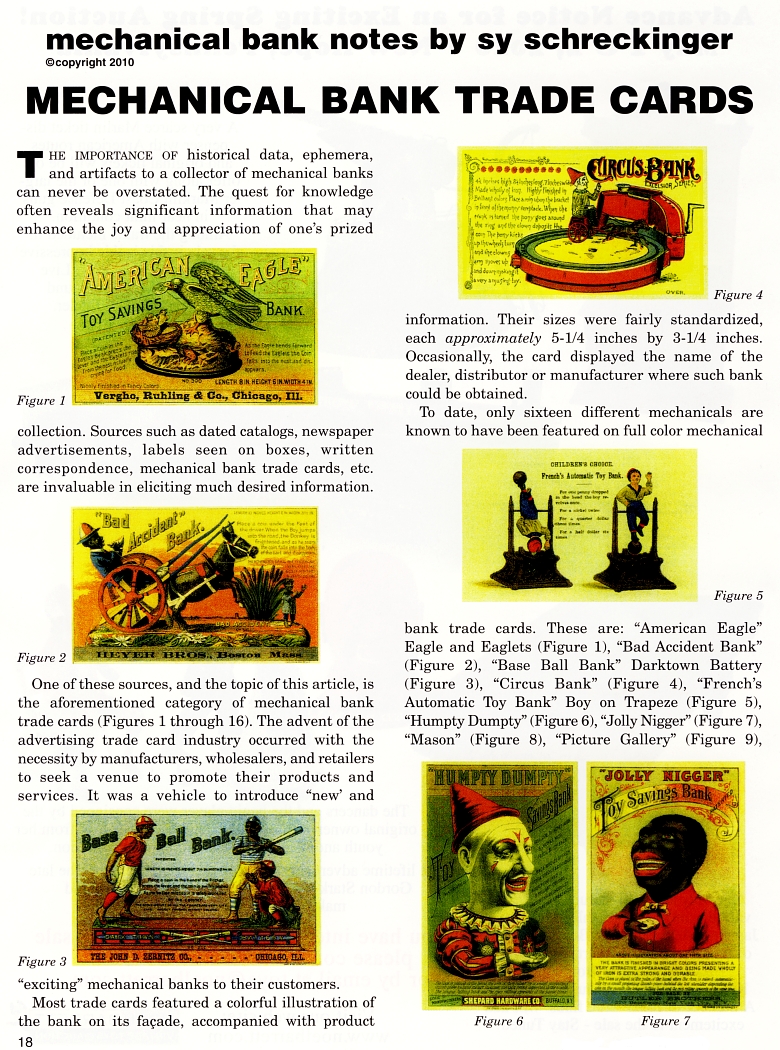|
Mechanical Bank Trade
Cards
by Sy Schreckinger – ANTIQUE TOY WORLD Magazine – January, 2010
The importance of
historical data, ephemera, and artifacts to a collector of mechanical
banks can never be overstated. The quest for knowledge often reveals
significant information that may enhance the joy and appreciation of one’s
prized collection. Sources such as dated catalogs, newspaper
advertisements, labels seen on boxes, written correspondence, mechanical
bank trade cards, etc. are invaluable in eliciting much desired
information.
One of these sources, and the topic of this article, is the
aforementioned category of mechanical bank trade cards (Figures 1 through
16). The advent of the advertising trade card industry occurred with the
necessity by manufacturers, wholesalers, and retailers to seek a venue to
promote their products and services. It was a vehicle to introduce “new’
and “exciting” mechanical hanks to their customers.
Most trade cards featured a colorful illustration of the bank on its
facade, accompanied with product information. Their sizes were fairly
standardized, each approximately 5-1/4 inches by 3-1/4 inches.
Occasionally, the card displayed the name of the dealer, distributor or
manufacturer where such bank could be obtained.
To date, only sixteen different mechanicals are known to have been
featured on full color mechanical bank trade cards. These are: “American
Eagle” Eagle and Eaglets (Figure 1), “Bad Accident Bank” (Figure 2), “Base
Ball Bank” Darktown Battery (Figure 3), “Circus Bank” (Figure 4),
“French’s Automatic Toy Bank” Boy on Trapeze (Figure 5), “Humpty Dumpty”
(Figure 6), “Jolly Nigger” (Figure 7), “Mason” (Figure 8), “Picture
Gallery” (Figure 9), “Punch and Judy” (Figure 10), “Stump Speaker” (Figure
11), “Speaking Dog Bank” (Figure 12), “Trick Dog” (Figure 13), “Uncle Sam”
(Figure 14), “Trick Pony” (Figure 15) and “Watch Dog Safe” (Figure 16).
Eleven of the trade cards advertise specific mechanical banks that
were manufactured by the Shepard Hardware Company of Buffalo, New York.
Four of the cards represented mechanicals produced by J. and E. Stevens
Company of Cromwell, Connecticut. The remaining card, namely “French’s
Automatic Toy”, promoted a mechanical produced by J. Barton Smith Company
of Philadelphia, Pennsylvania.
Vague explanations exist as to why Shepard Hardware and the J. and E.
Stevens Company chose to feature specific banks and exclude others for
their trade cards. It is also uncertain why several of the other
mechanical bank producers of the period, e.g. Kyser and Rex, the Judd
Manufacturing Company, Hubley, etc. did not incorporate the trade card
into their advertising promotions.
Mechanical bank trade cards are quite scarce, especially when found
in superb, bright and undamaged condition. This is understandable
considering the fragile nature of their paper composition which fares
poorly with age and/or the elements.
On a final note, exhibiting an assemblage of full color mechanical
bank trade cards together with a collection of mechanical banks most
certainly does enhance the display.
Acknowledgment: The cards shown in Figures 1 through 16 are from the
collections of Barry Seiden, Larry Feld, Greg Zemenick M.D. and author,
collector Bruce Roberts.
|


